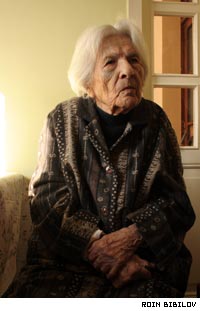Kevork Arslanian, 100, Survived Wwi Massacre
Richard M. Peery
Plain Dealer Reporter
Cleveland Plain Dealer, OH
March 30 2006
Garfield Heights- Kevork "George" Arslanian, 100, a survivor of the
slaughter of Armenians in Turkey during World War I and a Cleveland
barber since 1928, died Monday at Marymount Hospital.
Arslanian was living in Malatia, Turkey, when he and two siblings
were rescued by an uncle who had converted to Islam and a Muslim woman.
Their parents and other family members died in the massacre that took
an estimated 1.5 million Christian Armenians' lives.
Although 24 nations have labeled it an act of genocide, the Turkish
government denies responsibility for the deaths.
The children were placed in a Red Cross orphanage in Syria.
Another uncle in Cleveland tried to send for them but was blocked by
immigration quotas. The uncle provided passage to Cuba, where the
children shined shoes and did odd jobs for several years. In 1927,
prohibition-era rum runners smuggled them into the United States.
Arslanian never attended school beyond kindergarten, but he taught
himself to read using a dictionary and newspapers. He enrolled in
Miller Barber College and was awarded the 11th license issued in
Ohio. In 1932 he opened a barbershop with his brother.
Four years later, a friend wrote Arslanian to tell him about a young
woman in another city. She was Vergin "Virginia" Sarkisian, who had
also lived through the massacre and fled to Syria as a child.
He married her and brought her to Cleveland in 1936. They lived in
Garfield Heights for many years.
In 1955, Arslanian and his brother moved their shop to the former
Milo Theater at East 100th Street and Miles Avenue. His sons began a
rug-cleaning business in the back of the building in 1959 that grew
into one of the industry's leaders under the Arslanian Brothers name.
Although two years ago Arslanian stopped driving to the barbershop
to cut hair each Friday, he continued to help repair rugs one or two
days a week.
Arslanian was a founding member of St. Gregory of Narek Armenian
Church. The congregation built the area's first Armenian Orthodox
church in Richmond Heights in the 1960s. He remained one of its
leaders throughout his life.
He was often asked to speak at weddings, birthdays, anniversaries
and funerals. He was also active in the Armenian General Benevolent
Union and the Tekeyan Cultural Association.
To reach this Plain Dealer reporter:
[email protected], 216-999-4807
Kevork Arslanian
1905 - 2006
Survivors: Ted of Aurora, Henry of Solon and Armen of Independence;
nine grandchildren; and 22 great-grandchildren.
Services: 10:30 a.m. Friday at St. Gregory of Narek Armenian Church,
678 Richmond Road, Richmond Heights 44143.
Contributions: St. Gregory of Narek Armenian Church; Tekeyan Cultural
Association, Armenian Benevolent Union; all same address as the church.
Arrangements: Johnson-Romito of Bedford.
Richard M. Peery
Plain Dealer Reporter
Cleveland Plain Dealer, OH
March 30 2006
Garfield Heights- Kevork "George" Arslanian, 100, a survivor of the
slaughter of Armenians in Turkey during World War I and a Cleveland
barber since 1928, died Monday at Marymount Hospital.
Arslanian was living in Malatia, Turkey, when he and two siblings
were rescued by an uncle who had converted to Islam and a Muslim woman.
Their parents and other family members died in the massacre that took
an estimated 1.5 million Christian Armenians' lives.
Although 24 nations have labeled it an act of genocide, the Turkish
government denies responsibility for the deaths.
The children were placed in a Red Cross orphanage in Syria.
Another uncle in Cleveland tried to send for them but was blocked by
immigration quotas. The uncle provided passage to Cuba, where the
children shined shoes and did odd jobs for several years. In 1927,
prohibition-era rum runners smuggled them into the United States.
Arslanian never attended school beyond kindergarten, but he taught
himself to read using a dictionary and newspapers. He enrolled in
Miller Barber College and was awarded the 11th license issued in
Ohio. In 1932 he opened a barbershop with his brother.
Four years later, a friend wrote Arslanian to tell him about a young
woman in another city. She was Vergin "Virginia" Sarkisian, who had
also lived through the massacre and fled to Syria as a child.
He married her and brought her to Cleveland in 1936. They lived in
Garfield Heights for many years.
In 1955, Arslanian and his brother moved their shop to the former
Milo Theater at East 100th Street and Miles Avenue. His sons began a
rug-cleaning business in the back of the building in 1959 that grew
into one of the industry's leaders under the Arslanian Brothers name.
Although two years ago Arslanian stopped driving to the barbershop
to cut hair each Friday, he continued to help repair rugs one or two
days a week.
Arslanian was a founding member of St. Gregory of Narek Armenian
Church. The congregation built the area's first Armenian Orthodox
church in Richmond Heights in the 1960s. He remained one of its
leaders throughout his life.
He was often asked to speak at weddings, birthdays, anniversaries
and funerals. He was also active in the Armenian General Benevolent
Union and the Tekeyan Cultural Association.
To reach this Plain Dealer reporter:
[email protected], 216-999-4807
Kevork Arslanian
1905 - 2006
Survivors: Ted of Aurora, Henry of Solon and Armen of Independence;
nine grandchildren; and 22 great-grandchildren.
Services: 10:30 a.m. Friday at St. Gregory of Narek Armenian Church,
678 Richmond Road, Richmond Heights 44143.
Contributions: St. Gregory of Narek Armenian Church; Tekeyan Cultural
Association, Armenian Benevolent Union; all same address as the church.
Arrangements: Johnson-Romito of Bedford.









Comment